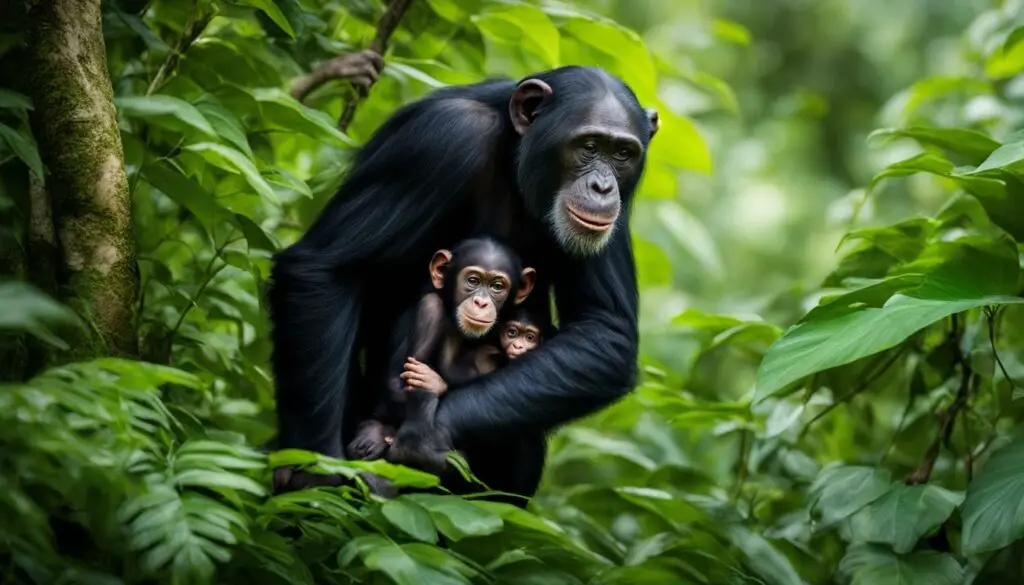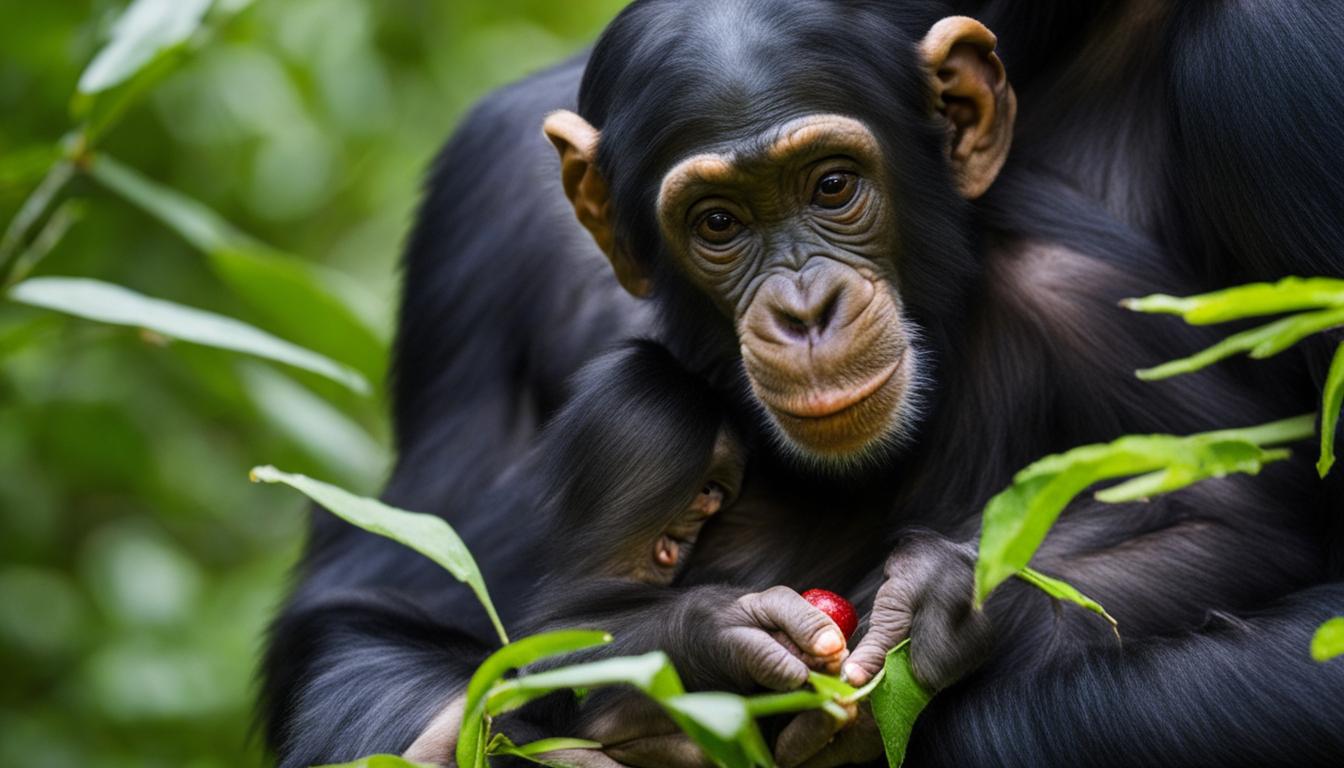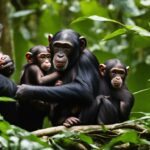Chimpanzee offspring, also known as baby chimpanzees, infant chimpanzees, young chimpanzees, or chimp babies, go through a fascinating journey of growth and development. In this article, we will explore the various stages of raising chimpanzee offspring and the unique challenges that mothers face in caring for their young.
Chimpanzee mothers typically give birth to one baby at a time. During the first month, the mother carries the baby under her belly, ensuring easy access to breastfeeding. As the baby grows older, usually around 6 to 12 months, it starts to venture out and explore its surroundings, always under the watchful eye of its mother.
Weaning usually occurs when the child is around five years old, as the mother becomes pregnant again. During this time, the young chimpanzee learns essential skills such as identifying safe food, understanding other members of the community, and even using tools. This learning process takes several years, with the mother providing guidance and support every step of the way.
Growth and Development of Chimpanzee Offspring
Chimpanzees, also known as chimps, exhibit remarkable growth and development throughout their early years. Understanding the stages of their development is crucial for caretakers and researchers alike. From birth to adulthood, chimp children go through various milestones that shape their journey towards independence.
During the first five months of life, baby chimpanzees rely heavily on their mothers for nourishment and protection. They are carried by their mothers and cling tightly to their fur, ensuring their safety as they explore the world around them. At around six months, they start taking their first steps, gradually gaining mobility and building strength in their limbs. By their first birthday, they weigh approximately 9kg, showcasing considerable growth since birth.
The relationship between the infant chimpanzee and its mother remains strong for at least two years. The mother provides constant care, allowing the young chimp to develop essential survival skills. During this time, the infant chimpanzee learns from and interacts with other members of the community, acquiring vital social and feeding behaviors. It is not uncommon to witness the young chimpanzee riding on its mother’s back until it reaches the age of four.
Chimpanzee Child Development Milestones:
- First five months: Clinging to mother’s fur and exploring surroundings
- Six months: Taking first steps and developing mobility
- One year: Weighing approximately 9kg, showcasing significant growth
- Two years: Learning essential skills from the mother and interacting with community members
| Age | Milestone |
|---|---|
| Birth to 5 months | Clinging to mother’s fur and exploring surroundings |
| 6 months | Taking first steps and developing mobility |
| 1 year | Weighing approximately 9kg, showcasing significant growth |
| 2 years | Learning essential skills from the mother and interacting with community members |
Social Interactions of Chimpanzee Offspring
When it comes to chimpanzee parenting, social interactions play a crucial role in the development of chimp babies. As a mother introduces her newborn to the rest of the community, there is an undeniable excitement among the group members. The young chimpanzee starts to make contact with play partners and explores its surroundings, eager to learn about the world around them.
However, despite this newfound curiosity, the mother chimpanzee always remains close by, ensuring the safety and well-being of her offspring. She provides constant guidance and protection, teaching the young chimp how to interact with others and navigate their social environment.
As the young chimpanzee grows older, it becomes more independent, and its interactions shift towards spending time with peers. This is a critical phase in their development, as they learn important social and feeding behaviors from their fellow chimpanzees. It is during this time that they form lasting bonds and acquire essential skills that will help them thrive in their troop.
The Importance of Peer Learning
Peer learning is a fundamental aspect of raising chimpanzee babies. Through observation and imitation, young chimps learn how to communicate, cooperate, and establish hierarchies within the group. They observe older chimpanzees in action, imitating their behaviors and gaining insights into the social dynamics of their community.
“Peer learning is an essential part of a young chimpanzee’s education. By interacting with their peers, they acquire the skills needed for survival and social integration within their troop.” – Dr. Jane Goodall
This hands-on learning experience helps them develop problem-solving abilities, understand the complex social structure of their troop, and acquire vital skills for finding food and navigating their environment. Peer learning is a testament to the adaptive nature of chimpanzees and their ability to pass down knowledge from one generation to the next.
| Benefits of Social Interactions for Chimpanzee Offspring: |
|---|
| Developing social skills |
| Acquiring feeding behaviors |
| Learning from older chimpanzees |
| Understanding the troop’s social dynamics |
In conclusion, the social interactions of chimpanzee offspring are essential for their development and successful integration into their troop. Through the guidance of their mothers and interactions with peers, young chimps learn valuable skills and behaviors that are crucial for their survival. The bond between mother and child remains strong throughout, ensuring that the young chimpanzee receives the necessary support and guidance needed to thrive in their social environment.
Reproduction and Birth in Chimpanzees
Female chimpanzees have a fascinating reproductive process that allows them to breed throughout the year. Their menstrual cycle is similar to humans, occurring approximately every 36 days. After a gestation period of around 8 months, the mother gives birth to a single baby chimpanzee. Twins are rare in chimpanzees, so most mothers have only one offspring at a time.
During the first few months of life, baby chimpanzees are heavily dependent on their mothers. They are carried everywhere and cling tightly to their mothers’ fur. It is a precious sight to see the mother and baby chimpanzee bonding in such a close and nurturing way. At around 6 months old, the baby chimpanzee starts to walk, taking its first steps towards independence.
By the time the baby chimpanzee is one year old, it weighs approximately 9kg and has started to explore its surroundings. However, the mother continues to provide care and protection, ensuring the well-being of her offspring. This close bond lasts for at least two years, and the mother often carries the older sibling on her back while caring for the new baby.
As the mother chimpanzee becomes pregnant again, the older sibling needs to navigate the world independently. This period of development is crucial for the young chimpanzee, as it spends more time with its peers and learns important social and feeding behaviors from them. The constant growth and reproduction in chimpanzee communities ensure the survival and growth of their species over time.

Table: Growth Milestones in Chimpanzee Offspring
| Age | Developmental Milestone |
|---|---|
| 0-5 months | Carried by the mother, clings to her fur |
| 6 months | Starts walking |
| 1 year | Weighs approximately 9kg, begins exploring |
| 2 years | Dependent on mother’s care, often carried on her back |
| 4 years | Mother gives birth to a new baby, older sibling becomes more independent |
Conclusion
Raising chimpanzee offspring is a fascinating and complex process. From the moment a baby chimpanzee is born, their mother provides constant care and protection. The mother carries the baby under her belly for the first month to facilitate easy breastfeeding. As the baby grows, it begins to explore its surroundings, always under the watchful eye of the mother.
The bond between a mother chimpanzee and her offspring is incredibly strong. The mother ensures that her baby learns essential skills for survival, such as identifying safe food, understanding other members of the community, and using tools. This learning process takes several years, as the young chimpanzee gradually gains independence.
While the mother focuses on raising her current offspring, she also needs to balance her attention with the arrival of a new baby. This challenge highlights the remarkable strategies that chimpanzees have developed to ensure the growth and survival of their species. It is through these strategies that chimpanzee babies, infants, and young chimps have the best chance of thriving in their natural habitat.
Are there any specific differences in raising chimpanzee offspring compared to other primates?
The raising chimpanzee offspring process involves unique challenges. Unlike other primates, chimpanzee mothers rely heavily on social learning to teach their young survival skills. Additionally, male chimpanzees play a significant role in childcare, which sets them apart from other primate species. These specific differences shape the upbringing of chimpanzee offspring.
FAQ
How many babies do chimpanzee mothers typically have at a time?
Chimpanzee mothers typically give birth to one baby at a time.
How long does the mother carry the baby under her belly?
The mother carries the baby under her belly for the first month to enable easy breastfeeding.
At what age does the baby chimpanzee start exploring its surroundings?
The baby chimpanzee starts exploring its surroundings after 6 to 12 months.
When does weaning usually occur?
Weaning usually occurs when the child is around five years old, as the mother becomes pregnant again.
What skills do chimpanzee offspring need to learn?
Chimpanzee offspring need to learn essential skills such as identifying safe food, understanding other members of the community, and using tools.
Do chimpanzees breed throughout the year?
Yes, chimpanzees breed throughout the year.
How long is the gestation period for chimpanzees?
The gestation period for chimpanzees is around 8 months.
How many babies are usually born per birth?
Usually, only one baby is born per birth.
How long does the mother take care of the baby?
The mother takes care of the baby for at least two years, sometimes riding on her back until it is four years old.
When does the older sibling chimpanzee become more independent?
The older sibling chimpanzee becomes more independent once the mother has another baby.
How often do female chimpanzees have menstrual cycles?
Female chimpanzees have menstrual cycles approximately every 36 days.










